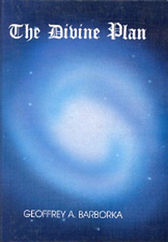The Divine Plan (book)
The Divine Plan – Written in the Form of a Commentary on H. P. Blavatsky's Secret Doctrine, by Geoffrey A. Barborka, Expressly for the Purpose of Those Who Wish to Read and Gain a Deeper Understanding of “The Secret Doctrine” – Presenting an Exposition of the Doctrines of the Esoteric Philosophy, Analysing and Explaining All the Terms Used was completed in 1958, and first published in 1961 by The Theosophical Publishing House, Adyar.
The Divine Plan presents an exposition of the esoteric doctrines of Cosmogenesis from Volume I of The Secret Doctrine, analyzing and explaining all the terms used. It is a commentary especially helpful for those who are considering reading The Secret Doctrine by Madame Blavatsky, or those who simply wish to read and gain a deeper understanding of its study.
Reviews
Laura Gaunt
Without any doubt this is one of the most important Theosophical books to come out since 1888, for it contains within its 564 pages the potential to revivify even the most moribund lodge with the trenchant rationality of H.P.B. The Divine Plan is not, and was not designed to be, a substitute for The Secret Doctrine, but by separating the essentially philosophical elements of the latter from the polemical method which H.P.B. was forced to employ Mr. Barborka has created an invaluable outline of the original teachings of Theosophy.
In "an exposition of the doctrines of the esoteric philosophy analysing and explaining all the terms used" Mr. Barborka has revealed to us the grand logic of the philosophical system expounded in The Secret Doctrine. You will say that this is not news to any student worthy of the name. True. However, this book is unique in its clarity and its modus operandi. Mr. Barborka has made every single point in his exposition by direct quotation from the original edition of The Secret Doctrine, from The Voice of the Silence, from Isis Unveiled, from Five Years of Theosophy, from The Theosophical Glossary, from Transactions of the Blavatsky Lodge, from The Mahatma Letters to A.P. Sinnett, and from The Letters of H.P. Blavatsky to A.P. Sinnett. Mr. Barborka's triumph is that now for the first time the Theosophical Society is in possession of a concise, clear, scholarly, and fully documented outline of those fundamental propositions which it has been its mission to propagate, however modestly. To quote from the Preface:
It will very soon be apparent that in this work The Secret Doctrine is being considered by means of subjects - or rather by Doctrines. In this method the chapters are arranged in a sequence which leads the mind from one doctrine to the next in an interrelated pattern.
Mr. Barborka has achieved the seemingly impossible task of analysis and exposition while remembering the limitations of the common reader. As he points out:
In order to read The Secret Doctrine understandingly it is necessary to know: (1) the meaning of a term itself - in the case of Sanskrit, going to the root-meaning of the word is of great importance; (2) the manner in which the term is used in relation to the passage; (3) the meaning of the whole passage; (4) the relation of the passage to the doctrine as a whole; (5) whether the term of passage is used in a generalizing sense or specifically; (6) whether a symbolical meaning is being employed; (7) whether more than one interpretation is applicable.
By careful quotation from the source books mentioned above Mr. Barborka has succeeded admirably in his task of clarification. As well, Sanskrit terms are explained as they are used, in detail, and an effective key to pronunciation is found at the beginning of the volume. In addition, after each quotation from The Secret Doctrine is given the page and volume reference for not only the original edition but also for the Third and Revised Edition, published in two volumes in 1893, and the Adyar 6 volume editions.
Indeed, if Mr. Barborka had written no more than his "enumeration" of the eight divine laws he would still deserve the gratitude of everyone who has ever tried to explain to a stranger what the Theosophical Society is all about! Following this brief definition in the "Introductory", The Law of Periodicity, The Law of Adjustment, The Law of Essential Unity, The Law of Self-Unfoldment, The Law of Motion, The Septenary Law, The Law of Compassion, The Law of Coming into Being are all explored in depth in the book proper.
Surely, the author's purpose to aid students and lecturers has been amply fulfilled! There is no longer the slightest shadow of an excuse for rambling or vagueness on the Theosophical platform when everyone, no matter how pressed for time, has it within his power to be fully informed.[1]
Joy Mills
Students of The Secret Doctrine have ling wished for a definitive guidebook which would chart a patterned course through those amazing volumes, delineating clearly the geographical features of that vast continent of thought comprising the esoteric philosophy that H.P.B. explored...
...His work, the fruition of a lifetime of study of H.P.B.'s writings, is a significant signpost on the road to the Wisdom, illuminating as it does the marvellous order which The Secret Doctrine portrays.[2]
Online resources
- The Divine Plan: Table of Contents from The Blavatsky Study Center.
- A Study of The Divine Plan webinar by Rev. John H. Drais of Madre Grande Theosophical Monastery (donation recommended).
